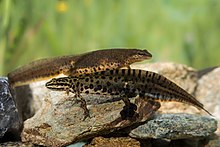The Greek smooth newt or Greek newt (Lissotriton graecus) is a newt species found in the southern Balkans, from southern Croatia (Dalmatia) over Montenegro, Albania and North Macedonia to Greece and south-westernmost Bulgaria.[3][4]: 234
| Greek smooth newt | |
|---|---|

| |
| Female (background) and male during breeding season | |
| Scientific classification | |
| Domain: | Eukaryota |
| Kingdom: | Animalia |
| Phylum: | Chordata |
| Class: | Amphibia |
| Order: | Urodela |
| Family: | Salamandridae |
| Genus: | Lissotriton |
| Species: | L. graecus
|
| Binomial name | |
| Lissotriton graecus (Wolterstorff, 1906)[1]
| |

| |
| Range (hatching indicates unclear contact zones with L. vulgaris and L. schmidtleri) | |
| Synonyms[2] | |
|
15 synonyms
| |
Willy Wolterstorff described the species in 1906 as Triton vulgaris graeca, a subspecies of the smooth newt.[1] After genetic data had suggested the smooth newt was a complex of distinct lineages,[5] Dubois and Raffaëlli, in 2009, recognised several subspecies, including the Greek smooth newt, as distinct species.[6] This was followed by subsequent authors.[2][3][7] Molecular phylogenetics suggested that the closest relative of the Greek smooth newt is Kosswig's smooth newt (Lissotriton kosswigi) from northwestern Anatolia.[7]
The species differs from other species in the smooth newt species complex mainly in the male secondary characters during breeding season.[3] The male dorsal crest is less than 1 mm high and has smooth edges. The belly has many small spots, but the lower tail fin is usually unspotted. The well-developed dorso-lateral folds give the body a square shape. Toe flaps on the hind feet are well developed.[4]: 234
The species's conservation status has not yet been evaluated separately from the smooth newt by the IUCN. Since its range is much smaller than that of the smooth newt species complex as a whole, it is likely to be more vulnerable than previously estimated. It has been negatively impacted by the introduction of fish.[3]
References
edit- ^ a b Wolterstorff, W. (1906). "Über Triton vulgaris L. subsp. graeca". Zoologischer Anzeiger (in German). 29: 137–139.
- ^ a b Frost, D.R. (2020). "Lissotriton graecus (Wolterstorff, 1906)". Amphibian Species of the World: An Online Reference. Version 6.1. New York, USA: American Museum of Natural History. doi:10.5531/db.vz.0001. Archived from the original on 25 April 2020. Retrieved 25 April 2020.
- ^ a b c d Wielstra, B.; Canestrelli, D.; Cvijanović, M.; et al. (2018). "The distributions of the six species constituting the smooth newt species complex (Lissotriton vulgaris sensu lato and L. montandoni) – an addition to the New Atlas of Amphibians and Reptiles of Europe" (PDF). Amphibia-Reptilia. 39 (2): 252–259. doi:10.1163/15685381-17000128. Archived from the original (PDF) on 28 April 2019.
- ^ a b Sparreboom, M. (2014). Salamanders of the Old World: The Salamanders of Europe, Asia and Northern Africa. Zeist, The Netherlands: KNNV Publishing. doi:10.1163/9789004285620. ISBN 9789004285620.
- ^ Babik, W.; Branicki, W.; Crnobrnja-Isailovic, J.; et al. (2005). "Phylogeography of two European newt species – discordance between mtDNA and morphology". Molecular Ecology. 14 (8): 2475–2491. doi:10.1111/j.1365-294X.2005.02605.x. ISSN 0962-1083. PMID 15969729. S2CID 7484766.
- ^ Dubois, A. & Raffaëlli, J. (2017). "A new ergotaxonomy of the family Salamandridae Goldfuss, 1820 (Amphibia, Urodela)". Alytes. 26: 1–85. S2CID 85602660.
- ^ a b Pabijan, M.; Zieliński, P.; Dudek, K.; Stuglik, M. & Babik, W. (2017). "Isolation and gene flow in a speciation continuum in newts". Molecular Phylogenetics and Evolution. 116: 1–12. doi:10.1016/j.ympev.2017.08.003. ISSN 1055-7903. PMID 28797693.